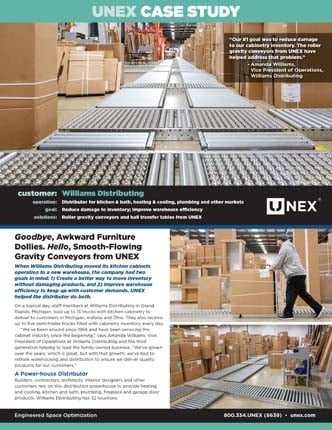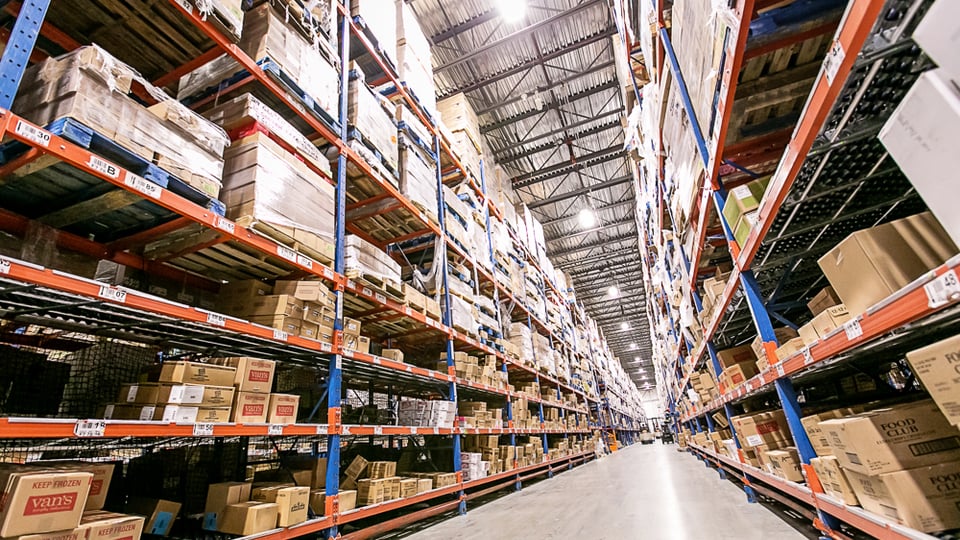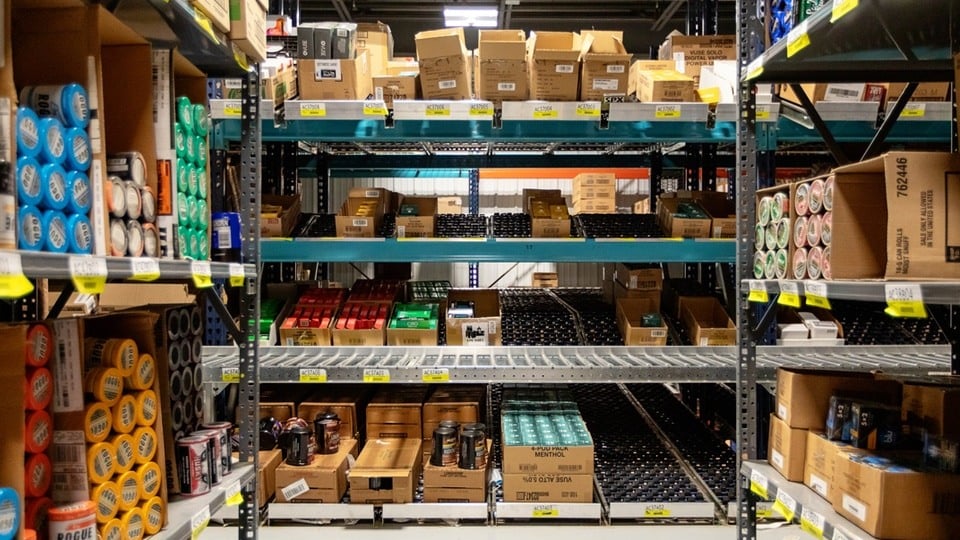Using Gravity Conveyors to Streamline Returns

Key Takeaways
- Returns are rising in eCommerce, and inefficient reverse logistics can create costly bottlenecks.
- Gravity conveyors improve returns processing by enabling smooth product flow through inspection, repackaging, and restocking stages.
- UNEX Gravity Conveyors offer flexible, low-maintenance solutions for streamlining reverse logistics.
Returns are an unavoidable fact of life for retailers. Especially in the age of eCommerce — when fewer customers see products first-hand before purchasing —send-backs are steadily on the rise. While retailers should do what they can to limit the number of returns, they’ll never eliminate them entirely.
What you can do is make the returns process vastly more efficient through better reverse logistics solutions. Even where returns are relatively low, they often come with inordinate costs due to ineffective processing in warehouses and retail backrooms.
For many retailers, gravity conveyors play a critical role in streamlining reverse logistics. Here’s a closer look at how retailers can use these simple but powerful tools to transform the returns process.
The Growing Impact of Returns in eCommerce Fulfillment
As consumers have shifted toward eCommerce, they’ve also accepted returns as part of the process. In 2023, Capital One Shopping reported that the average return rate for eCommerce was 26.4%, compared to only 10% for in-store purchases. Online sales returns increased by 7.22% that same year.
Retailers are well aware of the immediate revenue losses created by returns — especially where no exchange is involved. Yet, often lost in the picture are the larger costs of poorly managed returns processes:
- Slow restocking delays return processing and frustrates customers.
- Inefficient manual handling of returned merchandise increases labor costs and disrupts workflows.
- Reverse logistics backlogs create congestion in staging and inspection areas, potentially disrupting outgoing orders.
- Returned products aren’t properly reintegrated into inventory and may never be refurbished or resold.
The net effect of these inefficiencies can be far more costly than the dip in revenue from returned products. Ultimately, that’s why online retailers need to give more serious consideration to their reverse logistics solutions.

How Gravity Conveyors Streamline Returns Processes
Retailers now have countless options to make their reverse logistics processes more efficient. Technological advancements can help optimize processing and improve customer satisfaction, from faster online self-service returns portals to AI-driven analytics.
That said, none of these high-tech approaches will be as effective without a strong foundation where the returns actually take place — in the warehouses and backrooms. Where products come and go, gravity conveyors are an essential solution for reverse logistics.
Gravity conveyors are simple, low-cost, energy-efficient tools for moving inventory throughout an operation. They use rollers, wheels, and gravity to move products, minimizing manual handling without increasing power consumption or maintenance costs. As a key component in any dynamic storage and fulfillment layout, gravity conveyors also reduce worker movement and minimize workplace injuries.
Their lightweight, durable design makes gravity conveyors incredibly flexible and readily configurable, whether for permanent installations or temporary setups to meet fluctuating return volumes. They can be tailor-made with curves and various lengths to suit any warehouse layout and optimize the returns process. Whatever the demands of the season, products can move smoothly through the inspection, repacking, and restocking stages of the returns process.
Download the case study to learn how UNEX Gravity Conveyors revolutionized Williams Distributing's operation!

Key Applications of Gravity Conveyors in Reverse Logistics
Gravity conveyors can improve inventory flow throughout the returns process. Let’s consider what this looks like at four key stages in reverse logistics.
1. Returns Staging and Inspection Areas
Roller conveyors can streamline reverse logistics from the start by creating a simple, flexible way to stage returns right when they re-enter the warehouse. Efficiently move goods from the dropoff station along sloped rollers, through quality control zones for quick inspections, and into dedicated lanes for restocking, refurbishing, or disposal.
Establishing an efficient system for continuous flow in the returns process helps reduce bottlenecks and keeps everything moving smoothly. Workers can reach and inspect products at a comfortable height, while smooth rollers help to minimize product damage or hangups.
2. Repackaging Stations
Workers can connect returns inspection zones directly to repackaging stations, where items in good condition can quickly be reboxed to prepare for their return to shelves. There, products are queued up in an orderly fashion for fast restocking in first-in, first-out (FIFO) order.
Once again, the adjustability of these conveyor stations makes them easy to place at optimal height for workers to repackage goods, preventing unnecessary bending and strain. This ensures proper ergonomics throughout the reverse logistics process.

3. Restocking and Replenishment
Conveyors can be extended along shelves to minimize the need for walking as workers retrieve products for restocking. Whether items are returning to shelves or being sent directly back to fulfillment areas, gravity conveyors can streamline and accelerate the return of goods to active inventory locations.
These systems can be expanded and adapted to varying restocking needs throughout the year. As returns increase during the holidays, for instance, expanded restocking lines may be necessary to minimize disruptions in order fulfillment. Instead of a disorganized pile of returned products, gravity conveyors create an orderly, continuous flow from re-entry to restocking.
4. Dock Doors for Truck Loading and Unloading
Warehouses can also equip dock areas with gravity conveyors to speed up loading and unloading. Whether receiving returned merchandise or shipping out exchanged items, extendable conveyors allow for quick, efficient movement between the truck and the facility.
By keeping goods flowing steadily, gravity conveyors prevent dock congestion from pallets or carts while reducing the need for manual carrying. This creates a smoother, more efficient process that minimizes worker strain and optimizes space at the loading dock.
UNEX Gravity Conveyor Solutions for eCommerce Fulfillment and Returns
Among the most significant benefits of gravity conveyors is their flexibility. This isn’t a one-size-fits-all solution — it’s one that can be tailored to fit the unique needs of your operation.
That’s why UNEX offers several gravity conveyor options that can be adapted to serve both eCommerce fulfillment and reverse logistics processes. All UNEX Gravity Conveyors offer the same low-maintenance, smooth operation, but you can select the details that suit your situation.
For instance, all UNEX Gravity Conveyors come standard with an all-steel construction for maximum durability. Choose from several standard widths and lengths of up to 144 inches, with 45- or 90-degree curves to fit your layout. Adjustable supports allow you to set conveyor sections to the ideal height for your specific products and workforce.
You can apply many of these features to any of the three types of Gravity Conveyors from UNEX:
 |
JRS Series 1.38” Diameter Roller Conveyor: Perfect for conveying lightweight packages in flexible setups, this option can easily be moved or reconfigured as needs change. |
 |
MRS Series 1.9” Diameter Roller Conveyor: Designed for permanent installations, this heavier-duty option handles medium-weight packages. |
 |
SW Series Skatewheel Gravity Conveyor: For maximum flexibility, the SW Series allows for temporary conveyor lines to convey lightweight products during high-volume returns seasons. |
Whichever option you choose, you can further customize it with spurs, gravity gates, end stops, guard rails, permanent or portable supports, and more. Our extensive gravity conveyor solutions are easy to install, made to order, and proven to increase warehouse efficiency and throughput — for items going out and coming back in.
Driving Efficiency in Every Return
As eCommerce takes center stage in retail, returns will only become more common. Yet, an influx of product send-backs need not overwhelm retail backrooms and warehouses. With proper reverse logistics solutions, products can be reintegrated just as easily as they are shipped out.
UNEX Gravity Conveyors are the foundation of any frictionless retail fulfillment operation. These low-maintenance, durable, and flexible solutions streamline inventory flow in and out of the warehouse, simplifying returns processing throughout the year.
Some return costs are unavoidable — but many aren’t. Use gravity conveyors to weed out waste and make your reverse logistics as efficient as possible.
Ready to get started? Explore UNEX Gravity Conveyors and connect with our team of experts to design a solution to meet your needs!



